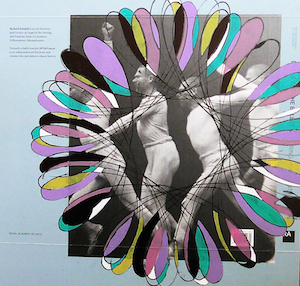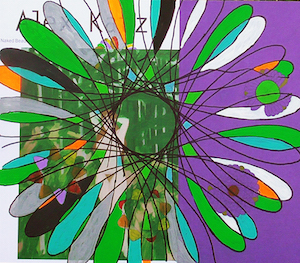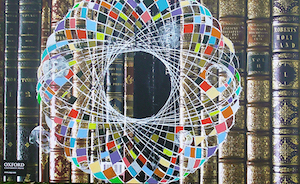In Motion
Exhibition
Friday 7 November to Saturday 22 November 2014
Susan Andrews, Allan Giddy, James Nguyen & Yin-Lan Soon, Mark Titmarsh and Laura Woodward
The exhibition will conclude with
Projection and Performance Night
Saturday 22 November from 7.30 – 9.30pm
See In Motion Event page for details
This project is supported by Marrickville Council
Motion In Exhibition Catalogue
Artist Profiles
Susan Andrews

Susan Andrews, Zip, 2014. Acrylic on pinewood, 183 x 105cm. Image: Susan Andrews
$3000.00

Running On Empty, 2014. Acrylic on pinewood and wheels, 35 x 90 x 30cm. Image credit: Susan Andrews
NFS
Susan Andrews has been a lecturer in painting at the National Art School since 2000. She has exhibited her work in numerous commercial, regional and artist run spaces (ARIs). Susan has a Master of Visual Art (Hons) UWS Nepean (1997), Graduate Diploma in Professional Art Studies and BFA from City Art Institute (1985) and a Certificate in Fine Arts from East Sydney TAFE 1981. She has undertaken artist residencies at Redgate Residency Beijing (2008-09), Bundanon Trust (2005), FONAS Studio Cité International des Arts, Paris (2005) Denise Hickey Memorial Studio (2000). Susan was a finalist in the 2014 Grace Cossington Smith Art Award
Motion implies a change in position; it can also refer to displacement, speed and time or at least a change in direction. To observe these phenomena our physical body needs to be in a stable position, we then need a frame of reference from which we can observe and measure these changes.
In terms of painting on a static surface the idea or the illusion of motion was best conjured by exploring notions of displacement through shifts in colour applied onto planar surface. Brightly coloured stripes are painted on the planar surface of each of the two works In Motion.
The vertical planks of wood are painted with brightly contrasting colour often found in exercise clothes or training gear. The floor work is an open cube on wheels; painted both black and multi-coloured. This construction is made out of square stretcher bars and alludes to being a functioning object, but on closer inspection one soon realises that the inclusion of empty spaces renders it non-functional.
These two works explore notions around spatiality and displacement through the application of contrasting and/or complimentary colour and thereby creating physical unease or instability in the awareness of the viewer and their perceptions of space.

The Gate, 2014. Video screens and electronics, 50 x 50 x 14cm. Image credit: Allan Giddy
$2200.00 (with two archived screens)

Allan Giddy, Just Before The New Dawn, 2013. Vibration sensitive sculpture. Steel spring, Tarantula and glass fronted case, 60 x 20cm. Image: AirSpace Projects
NFS
Allan’s pioneering use of alternative energy systems and light in ‘time-based sculpture’ began in 1992. Over time his practice has expanded into the public domain, specifically public sited ‘active sculpture’ aimed at the reinvigoration of public spaces.
He is one of Australia’s foremost proponents of sustainable energy systems, electronic interconnectivity and interactivity embedded in the physical art object.
“Upon the securing of the wall. Major Thompson ordered the new company under his command, Company L, to capture the southern gate and the immediate area outside the Citadel leading to the bridge across the river. The company commander, Captain John D. Niotis, made his preparations for the assault. Major Thompson set up his temporary command post in a building about 300 meters from the objective so that he could witness the attack. Thompson recalled it was ‘a classic combined arms effort that could not have been executed better on a blackboard.’ The sun was out for the first time in two weeks and Marine fixed-wing aircraft dropped napalm within 800 meters of the advancing troops.” Ohio University History Site
Allan would like to acknowledge the following children for their contribution to his project: Ava age 11, Asha age 10 , Giselle age 2, Jamilla age 4, Jenna age 9, Lola age 11, Mia age 12, Mo age 11, Ollan age 5 and Olie age 15
James Nguyen & Yin-Lan Soon

Manual Pan 2 (Roundabout), 2014. digital photograph. James Nguyen/image courtesy of the artist.
NFS
James Nguyen is an Australian artist with a background in painting and installation, completing his undergraduate studies at the National Art School. His current MFA research at the Sydney College of Art (the University of Sydney) explores the performative potential of the camera. Nguyen also extends his practice with various online, writing and collaborative projects.
Yin-Lan Soon works as a doctor in the field of mental health. She enjoys using ballet and contemporary dance as a form of creative expression and as a counter balance to her medical working life.
I’ve been looking at the idea of communal exercise as a form of state aesthetic: looking at how people in China use public space as opposed to an enclosed gym to exercise. It seems at once public and openly demonstrates ones physical responsibility as a state enterprise: I still haven’t worked out a relevant format, but and thinking of replicating movement and using the green screen to amplify these. It’s still in process but should be easy to put together back home.

Picturing Movement, 2014. Acrylic on paper (dust jacket), 48.3 x 37.5 cm. Image Credit: Mark Titmarsh
$850.00

UM, 2014. Gouache and acrylic on paper (dust jacket), 27.5 x 40.5 cm. Image credit: Mark Titmarsh
$750.00

From the Land, 2014. Gouache on paper (dust jacket), 32.7 x 32.4 cm. Image credit: Mark Titmarsh
$750.00

Naked Beauty, (2014), gouache and acrylic on paper (dust jacket), 23.7 x 27.5 cm. Image credit: Mark Titmarsh
$650.00

Arcadian Library, 2014. Gouache and acrylic on paper (dust jacket), 32 x 52.3 cm. Image credit: Mark Titmarsh
$850.00
Mark Titmarsh (born 1955, Ingham, Australia, PhD, UTS, 2009) is a visual artist working in painting, screen media and writing. His current ‘expanded painting’ work is painting about painting or painting that dissimulates into objects, videos and texts. He is a tenured, part time lecturer in the School of Design, University of Technology, Sydney. His artworks are held in the collection of the National Gallery of Australia, most State Galleries, and in private collections overseas. He has also published widely including the journal Art Monthly Australia and contributed to the book Baudrillard Live.
These works are all spirograph patterns painted on dustjackets of books. The spirograph creates forms that are paradoxically somewhere between geometric and biomorphic. They are geometric because a device that can only produce regular and repetitious curves like those mass-produced in an industrial context makes all the shapes mechanically. They are biomorphic in that all the curved shapes resemble the natural fluid forms found in nature, as in the concentricity of flowers, the Fibonacci spiral of shells, fractals of snowflakes, iterations of leaves, vortices of clouds, oscillations of waves, foaming of surf, tessellation of crystals, crazing of dried paint, and the camouflage of wildlife.
It was the sight of dazzle camouflage painted on the side of WW1 weaponry that inspired Picasso to say, that he and other avant garde artists had invented the look since it was essentially cubist. Dazzle camouflage, unlike other camouflage that blends in to the background, did not attempt to conceal but to confuse, making it difficult for the enemy to know what they were looking at, where it was exactly and whether it was moving or vibrating on the spot.
The spirographic overlay on the dustjacket of a book is a way of dazzling and fragmenting the strict graphic rules of book design and typography. It interrupts the flow of information, partially obscuring what lies beneath, leaving only traces of half words and displaced images. The play of paint inside the spirograph uses the structure and pattern of elliptical overlappings as an opportunity for a display of colour similar to a colour wheel tipped off balance and spread out beyond its scientific boundaries.

Five (detail), 2014. Mixed media. Image credit: Jem Selig Freeman.
POA
Laura Woodward lives and works in Melbourne, Australia. She has been creating sculptural kinetic installations for six years. Laura’s current explorations focus on the idea of an introverted kinetic sculpture. The introverted kinetic sculpture has a logic that comes from within. The system, motion and form are crucial elements of the introverted sculptures and, in the most introverted, are totally inseparable from each other. This logic both produces and is generated by the introverted sculpture.
Solo shows include The Saltus at Place Gallery, Richmond, in 2011, Underwing at Linden Centre for Contemporary Arts, St Kilda, and Shimmer at Place Gallery, Richmond, both in 2010, as well as Pulse at Bus Gallery in 2008. Group exhibitions include Sensory Worlds at Inspace, Edinburgh, Scotland and Lorne Sculpture, both in 2011; the 2007 and 2010 McClelland Sculpture Survey and Award; Tips for Anxious Gardeners, the Library Artspace, Fitzroy, 2009; and Convergence at 9 Yarra, commissioned as part of the State of Design Festival, 2009. Laura received an Australia Council Emerging Artist New Work Grant in 2010; was the winner of the Agendo Prize for Emerging Artists in 2009; and received both the Vulcan Steel Postgraduate Tutorship Award and a Freedman Foundation Travelling Scholarship Award in 2007. She has also been short-listed for numerous awards and commissions, including the Melbourne Fire Brigade memorial for fallen fire-fighters at Burnley and recently the Horsham Entrances Highway Sculpture Commissions. Laura completed a Masters of Fine Art at the Victorian College of the Arts, the University of Melbourne, in 2008, and is currently undertaking a Doctorate of Philosophy at the same institution.
Click here to read Town Hall Gallery: Laura Woodward: In Conversation.
The work focuses upon the reliance and response that occurs between various interconnected components that make up any particular ‘system’. This responsiveness and interconnection is, in fact, fundamental to discerning the difference between an assembly and a system. The work is inherently and intentionally ambiguous, instead asking the viewer to determine for themselves what the system at play might be, and what it is systematically doing.
Laura Woodward’s project has been assisted by the Australian Government through the Australia Council, its arts funding and advisory body.



0 Comments